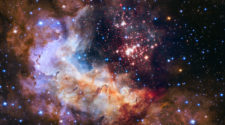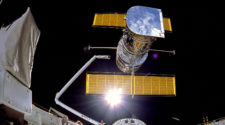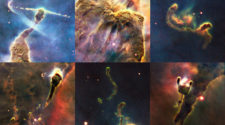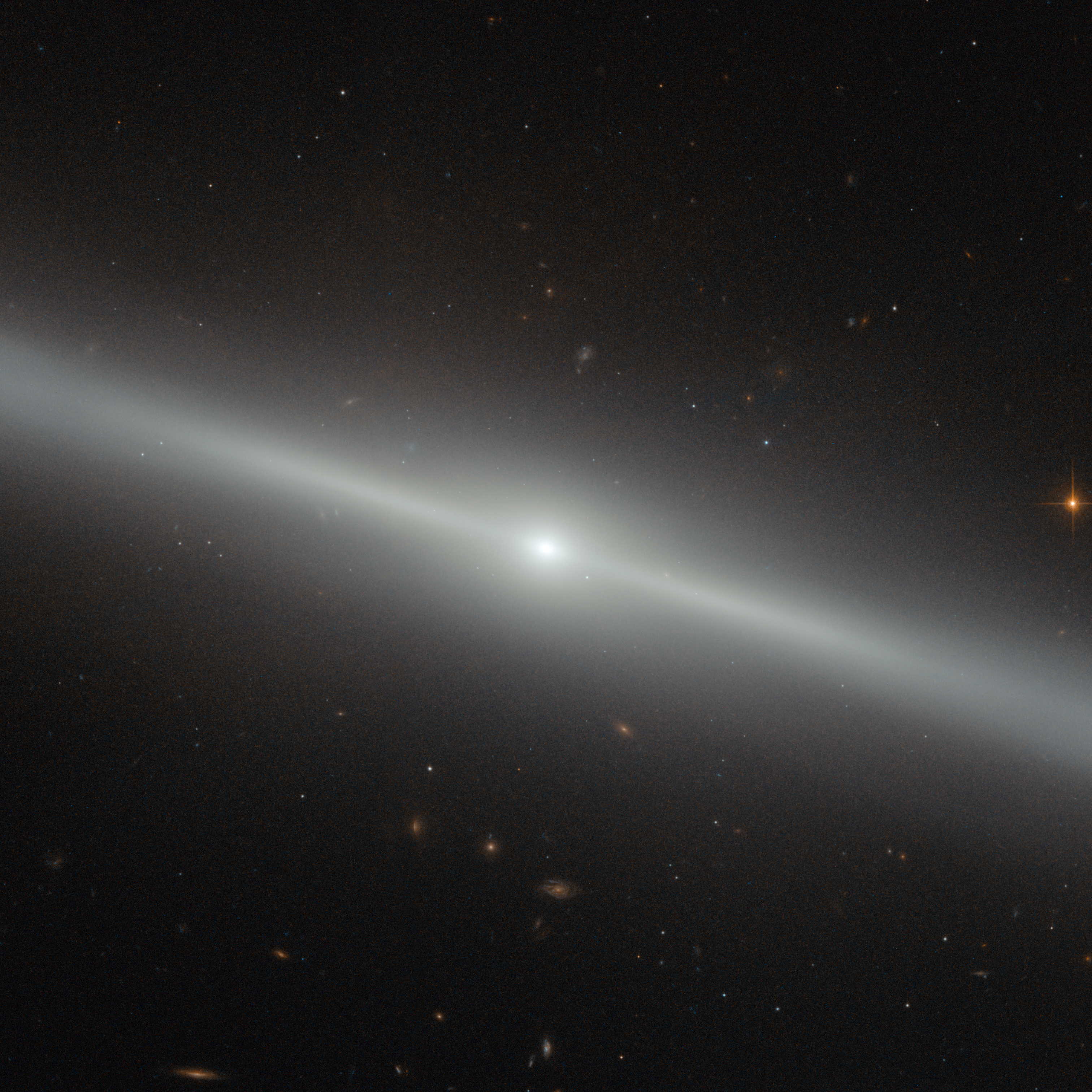
71. A galaxy on the edge
The bright streak slicing across the frame of this spectacular image is an edge-on view of galaxy NGC 4762, and a number of other distant galaxies can be seen scattered in the background.
Previously thought to be a barred spiral galaxy, NGC 4762 has since been found to be a lenticular galaxy, a kind of intermediate step between an elliptical and a spiral. The edge-on view that we have of this particular galaxy makes it difficult to determine its true shape.
The galaxy’s disc is asymmetric and warped, which could potentially be explained by NGC 4762 violently cannibalising a smaller galaxy in the past. The remains of this former companion may then have settled within NGC 4762’s disc, redistributing the gas and stars and so changing the disc’s morphology.
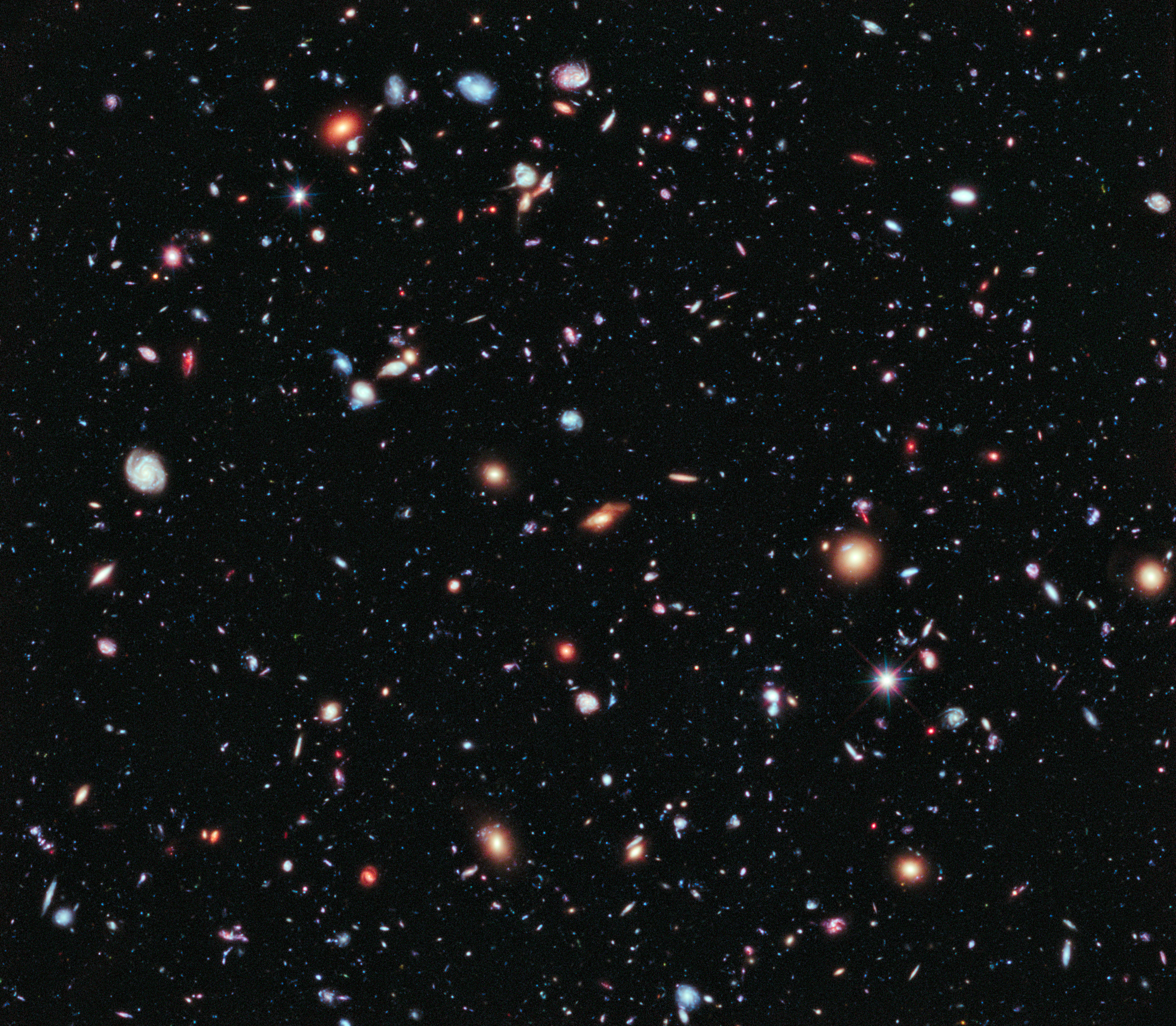
72. The Hubble eXtreme Deep Field
This image, called the Hubble eXtreme Deep Field (XDF), combines Hubble observations taken over the past decade of a small patch of sky in the constellation of Fornax. With a total of over two million seconds of exposure time, it is the deepest image of the Universe ever made, combining data from previous images including the Hubble Ultra Deep Field (taken in 2002 and 2003) and Hubble Ultra Deep Field Infrared (2009).
The image covers an area less than a tenth of the width of the full Moon, making it just a 30 millionth of the whole sky. Yet even in this tiny fraction of the sky, the long exposure reveals about 5500 galaxies, some of them so distant that we see them when the Universe was less than 5% of its current age.
The Hubble eXtreme Deep Field image contains several of the most distant objects ever identified.
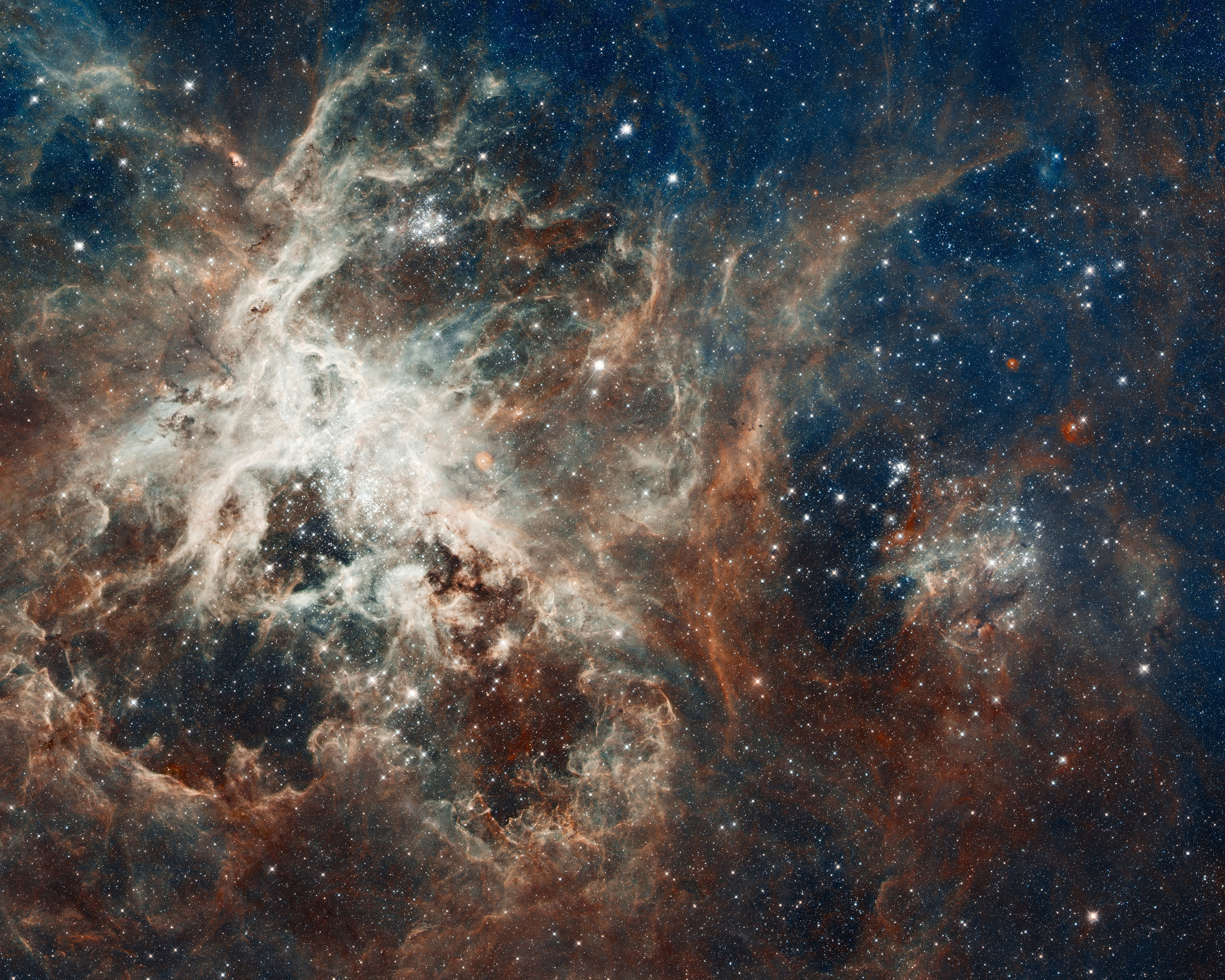
73. Panoramic view of a star-forming region
30 Doradus is the brightest star-forming region in our galactic neighbourhood and home to the most massive stars ever seen. The nebula resides 170 000 light-years away in the Large Magellanic Cloud, a small, satellite galaxy of our Milky Way. No known star-forming region in our galaxy is as large or as prolific as 30 Doradus.
The image comprises one of the largest mosaics ever assembled from Hubble photos and includes observations taken by Hubble’s Wide Field Camera 3 and Advanced Camera for Surveys, combined with observations from the European Southern Observatory’s MPG/ESO 2.2-metre telescope which trace the location of glowing hydrogen and oxygen.
The image was released to celebrate Hubble’s 22nd anniversary.
“A satellite galaxy of the Milky Way, the Large Magellanic Cloud, is hosting one of the most violent nearby regions of star formation. While I was at Space Telescope [STScI] we proposed to observe this region with Hubble and make one of the largest mosaic images that Hubble ever made.
“This program was lead by D. J. Lennon and E. Sabbi. The resulting image was not only scientifically very useful, it was also simply extremely beautiful. It was released as Hubble’s 22nd birthday image.
“Looking at it on a computer screen does not do justice to this incredibly large image. It should really be printed and be several meters wide, so you can stand in front of it and fully appreciate it.”
Dr. Selma E. de Mink
Assistant Professor
University of Amsterdam
Netherlands
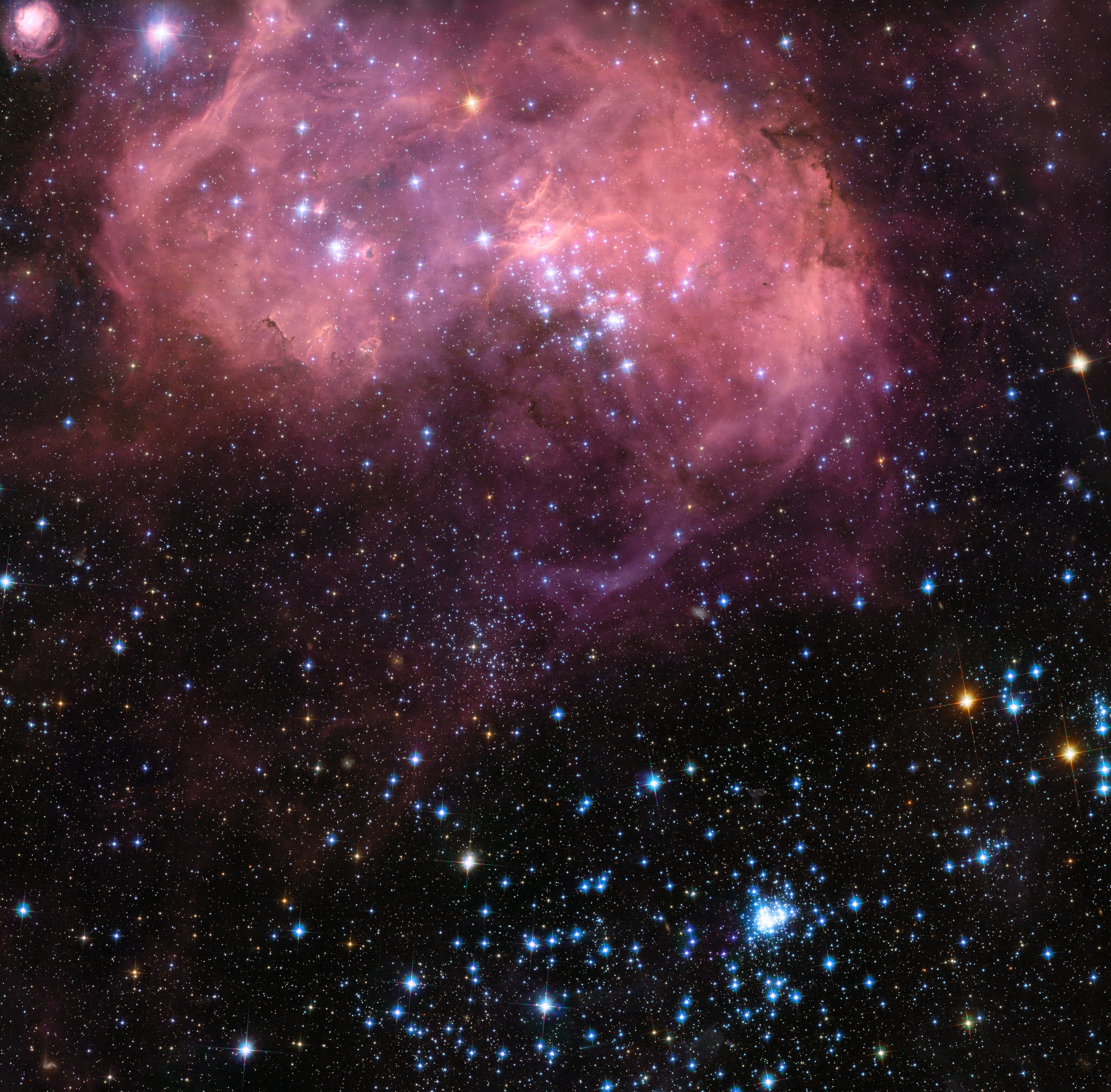
74. Huge star formation region N11 in the LMC
This broad vista of young stars and gas clouds in our neighbouring galaxy, the Large Magellanic Cloud, was captured by Hubble’s Advanced Camera for Surveys (ACS). This region is named LHA 120-N 11, informally known as N11, and is one of the most active star formation regions in the nearby Universe. This picture is a mosaic of ACS data from five different positions and covers a region about six arcminutes across.
“I entered the field of astronomy when Hubble was already in its ‘prime’ years, so it is hard for me to imagine a world without Hubble and the amazing discoveries that have resulted. Hubble has rewritten the textbooks, exploring all scales of the universe. Humanity would be at a great loss without the fundamental discoveries of the Hubble Space Telescope.”
Dr. Katherine E. Whitaker
NASA Postdoctoral Program Fellow
Goddard Space Flight Center
Greenbelt, Maryland
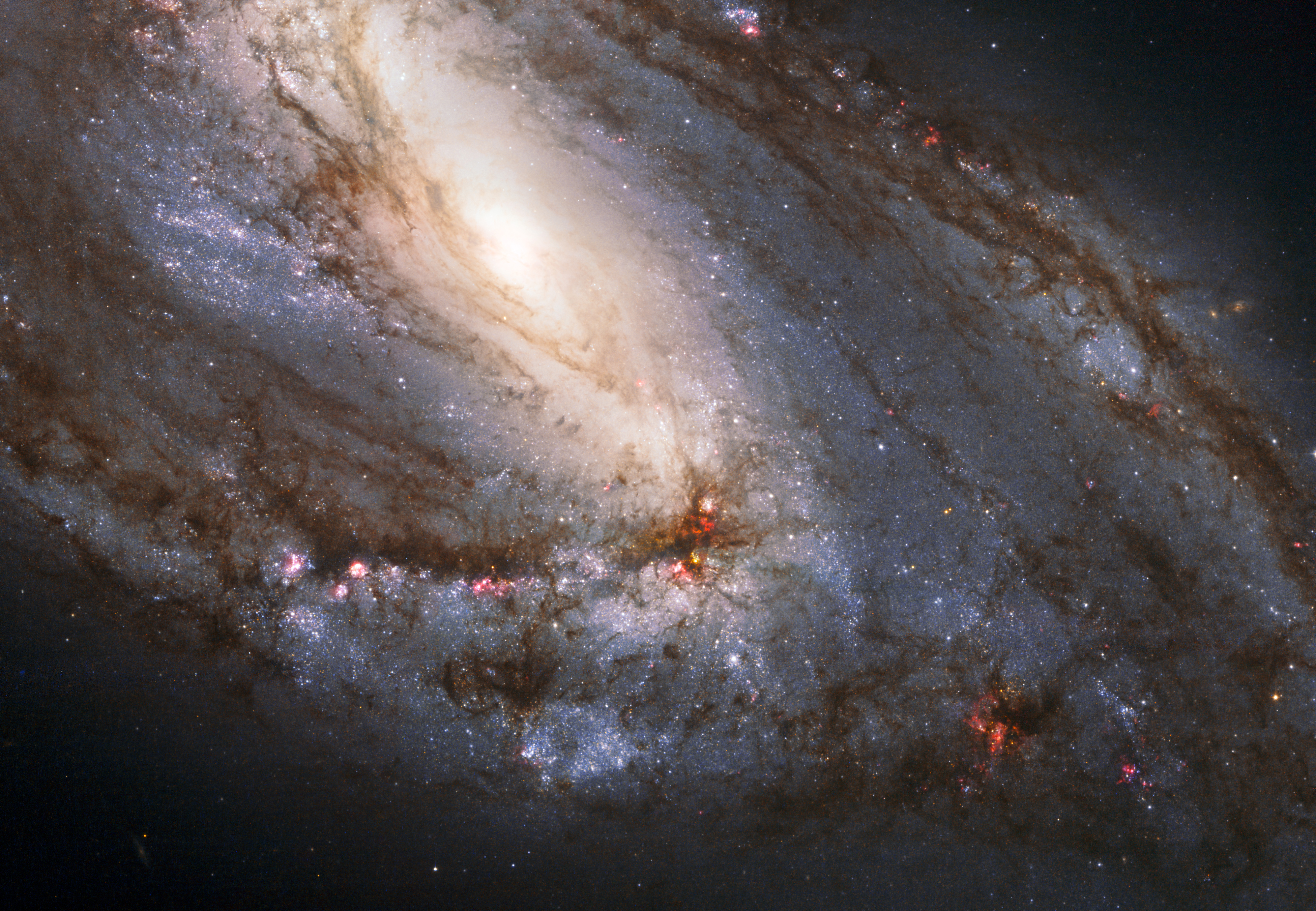
75. Heavyweight of the Leo Triplet
Hubble has snapped a spectacular view of M66, the largest “player” of the Leo Triplet, and a galaxy with an unusual anatomy: it displays asymmetric spiral arms and an apparently displaced core. The peculiar anatomy is most likely caused by the gravitational pull of the other two members of the trio.
The unusual spiral galaxy, Messier 66, is located at a distance of about 35 million light-years in the constellation of Leo. Together with Messier 65 and NGC 3628, Messier 66 is the member of the Leo Triplet, a trio of interacting spiral galaxies, part of the larger Messier 66 group. Messier 66 wins in size over its fellow triplets — it is about 100 000 light-years across.
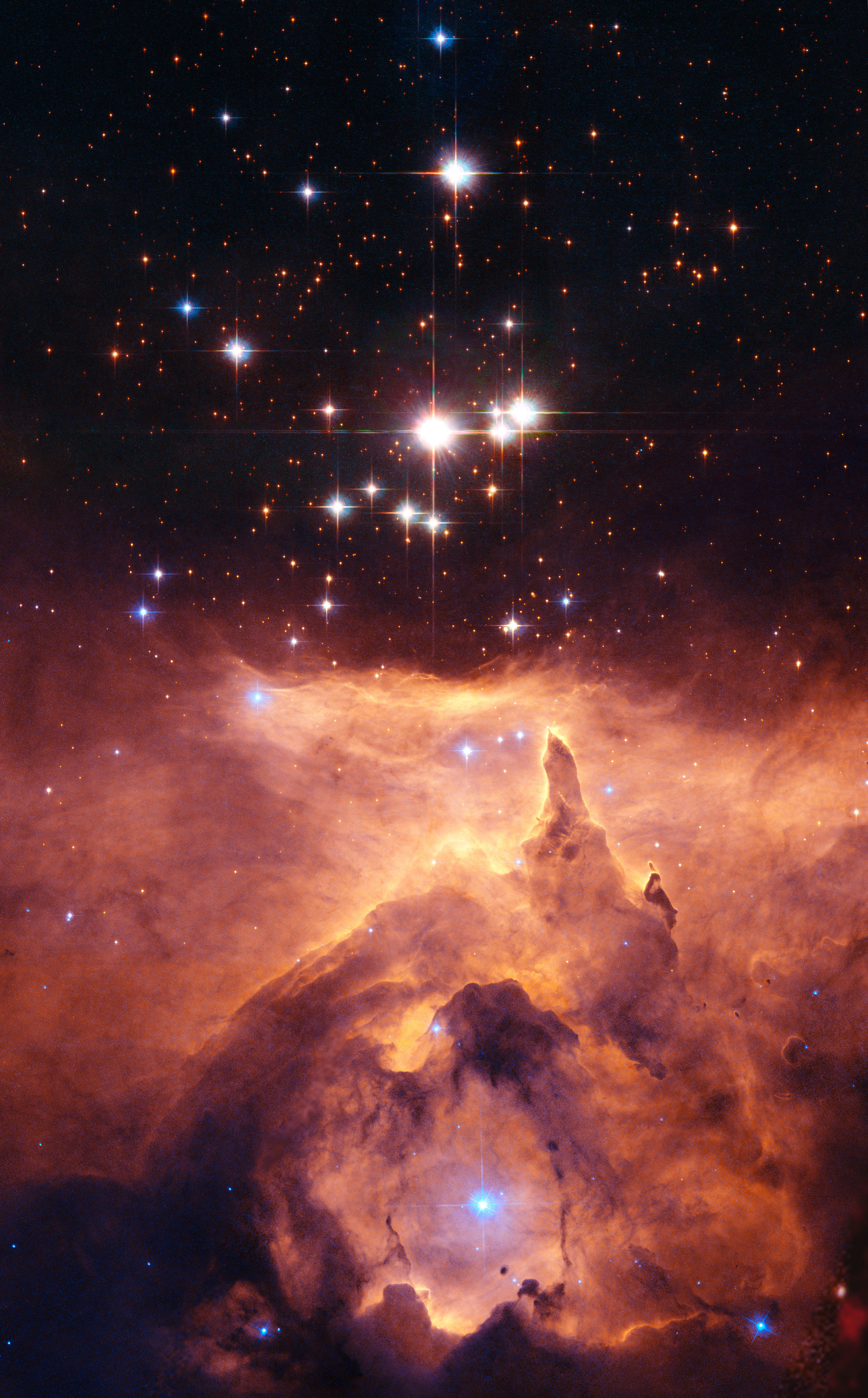
76. Star on a Hubble diet
The star cluster Pismis 24 lies in the core of the large emission nebula NGC 6357 that extends one degree on the sky in the direction of the Scorpius constellation. Part of the nebula is ionised by the youngest (bluest) heavy stars in Pismis 24. The intense ultraviolet radiation from the blazing stars heats the gas surrounding the cluster and creates a bubble in NGC 6357. The presence of these surrounding gas clouds makes probing into the region even harder.
One of the top candidates for the title of “Milky Way stellar heavyweight champion” was, until now, Pismis 24-1, a bright young star that lies in the core of the small open star cluster Pismis 24 (the bright stars in the Hubble image) about 8,000 light-years away from Earth. Pismis 24-1 was thought to have an incredibly large mass of 200 to 300 solar masses. New Hubble measurements of the star, have, however, resolved Pismis 24-1 into two separate stars, and, in doing so, have “halved” its mass to around 100 solar masses.
“Over the past 25 years, the HST, or Hubble to most astronomers, has revolutionized most fields of astronomical research, including studies of our own Solar System. This is especially true in astronomer’s efforts to understand the denizens of the Kuiper Belt.
“Colloquially named after Gerard Kuiper, one of the first astronomers to propose the existence of the Kuiper Belt, the Kuiper Belt resides at and beyond the orbit of Neptune. Possessing as many as a few hundred dwarf planets including the most famous, Pluto, the Kuiper Belt presents an enigmatic picture of a population that was well on its way to forming a planet, but ultimately failed.
“Hubble has enabled many critical discoveries about the physical nature of Kuiper Belt objects. Most Kuiper Belt objects reside at more than 40 times further from the Sun than does the Earth. Due to their comparatively small sizes, those objects remain unresolved (or are only barely resolved) even to Hubble. As a result, HST images of KBOs are generally unremarkable.
“This isn’t true however, for the Kuiper Belt’s substantial binary population, the discovery of which is one of Hubble’s key findings regarding the Kuiper Belt. Roughly 20% of KBOs are in binary, or higher multiplicity systems, including Pluto; beyond Charon, Pluto has four small satellites all of which were discovered in HST images – the image of Pluto and its siblings is one of my personal favorites. By observing the motions of these multiple systems, astronomers have been able to directly measure the masses of these binary systems. Further, Hubble has helped reveal peculiar aspects of the formation of these systems, including: the massive collisions responsible for the formation of the satellite systems around the largest KBOs, like Pluto and his brother, Eris; or the currently unexplained coeval growth that smaller KBOs must have experienced to produce the nearly identical compositions found for each member of a given pair.”
Dr. Wesley Fraser
Plaskett Fellow
Herzberg Institute of Astrophysics
Victoria, BC, Canada
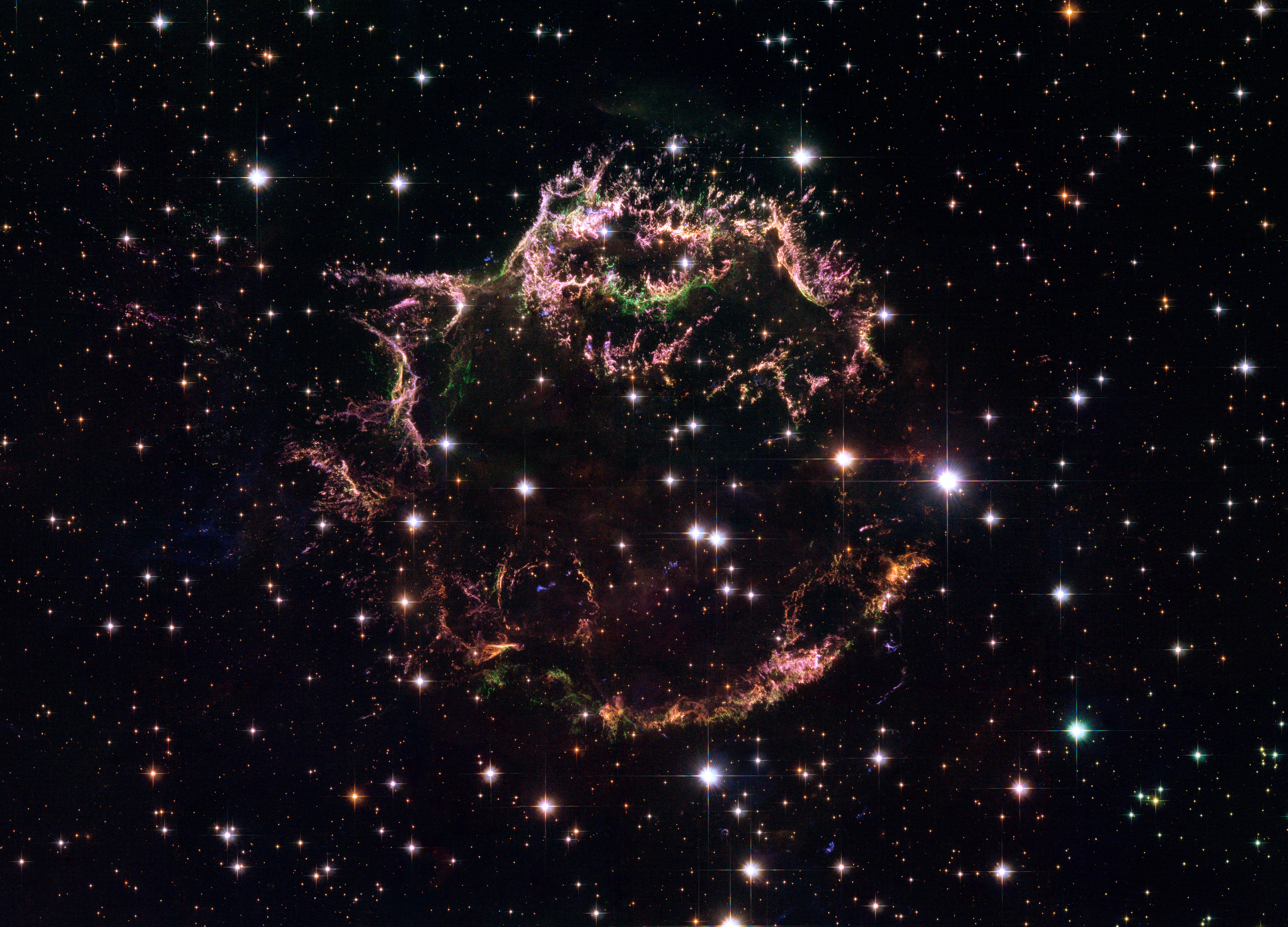
77. Colourful aftermath of a violent stellar death
This image provides a detailed look at the tattered remains of a supernova explosion known as Cassiopeia A (Cas A). It is the youngest known remnant from a supernova explosion in the Milky Way. The new Hubble image shows the complex and intricate structure of the star’s shattered fragments.
“Hubble’s lasting legacy will be that we HAVE to do certain types of astronomy from space. We will always need assets in space if astronomy is to advance.”
Dr. Bradley M. Peterson and Dr. Gisella De Rosa
(Peterson) Professor and Chair of Astronomy, Ohio State University, Columbus, Ohio
(De Rosa) Visiting Astronomer, Space Telescope Science Institute, Baltimore, Maryland
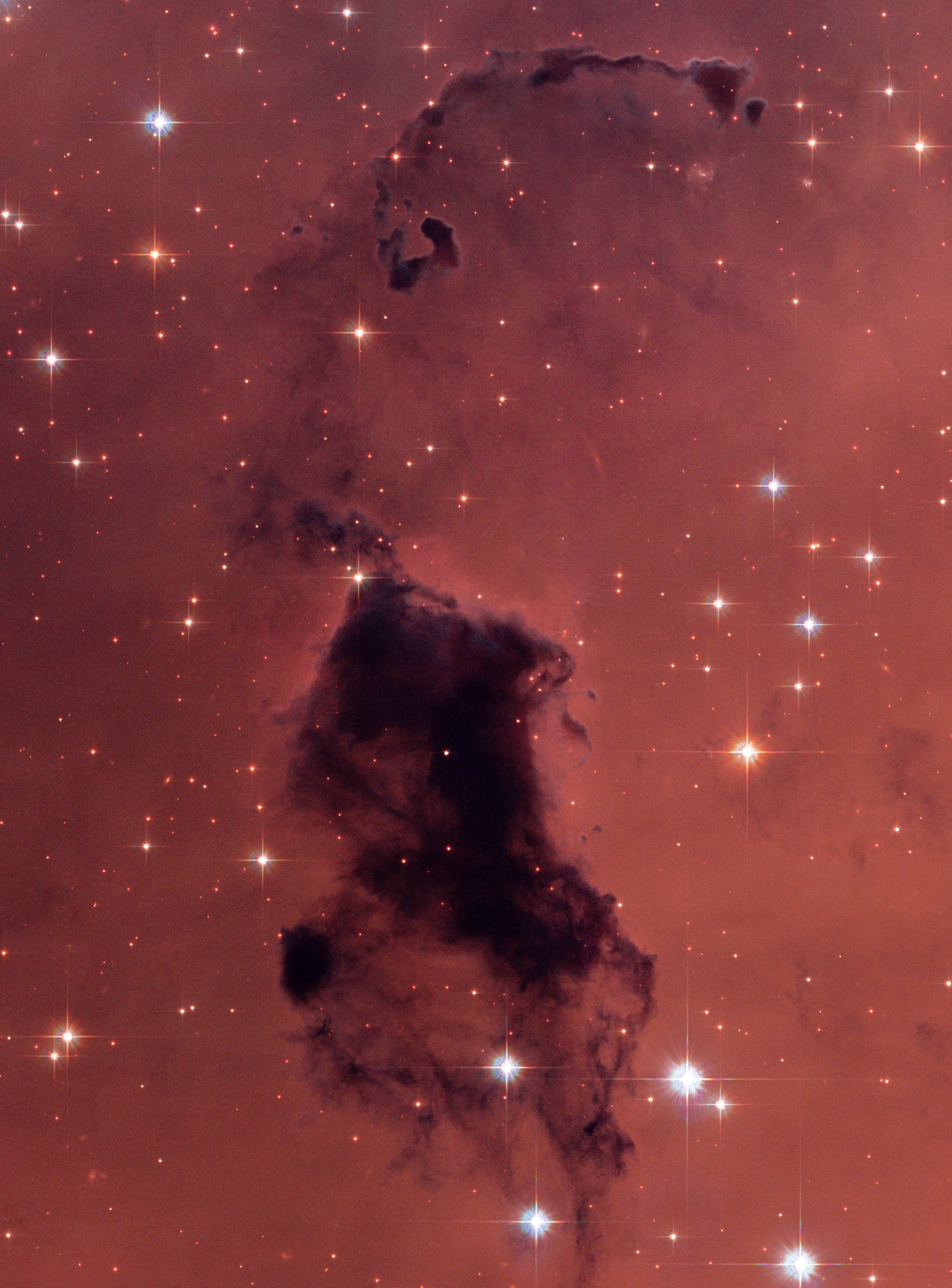
78. Nearby dust clouds in the Milky Way
The yearly ritual of spring cleaning clears a house of dust as well as dust “bunnies”, those pesky dust balls that frolic under beds and behind furniture. Hubble has photographed similar dense knots of dust and gas in our Milky Way Galaxy. This cosmic dust, however, is not a nuisance. It is a concentration of elements that are responsible for the formation of stars in our galaxy and throughout the universe.
These opaque, dark knots of gas and dust are called Bok globules, and they are absorbing light in the center of the nearby emission nebula and star-forming region, NGC 281. The globules are named after astronomer Bart Bok, who proposed their existence in the 1940’s.
“Another critical discovery enabled by Hubble is the indirect discovery of an abundant population of small, roughly 1 km diameter Kuiper Belt objects. By virtue of their small sizes, KBOs smaller than ~10 km in diameter are too faint to be observed directly, even by the HST. Remarkably however, a pair of objects smaller than 1 km diameter have been observed by the Fine Guidance Sensors, detectors whose main purpose is to keep Hubble locked on the stars. Those sensors detected the shadows cast by the small Kuiper Belt objects as they passed in front of the stars Hubble was observing. While astronomers are still trying to understand the full significance of this discovery, it appears that these small bodies are the fragments produced during a state of significant collisional bombardment, a process that may have been partially responsible for the failure of the Kuiper Belt to form another full planet.
“With its unique imaging capabilities, Hubble has enabled countless discoveries about the Kuiper Belt and the outer Solar System. The images it has taken of Pluto’s surface and satellite family are just a sample of the iconic images captured in NASA’s top 100 images produced by the Hubble Space Telescope. No other telescope has equally captured the wonder and imagination of the public and the astronomer alike, earning Hubble’s place as not just the most influential telescope facility, but arguably the most influential science facility in general.”
Dr. Wesley Fraser
Plaskett Fellow
Herzberg Institute of Astrophysics
Victoria, BC, Canada
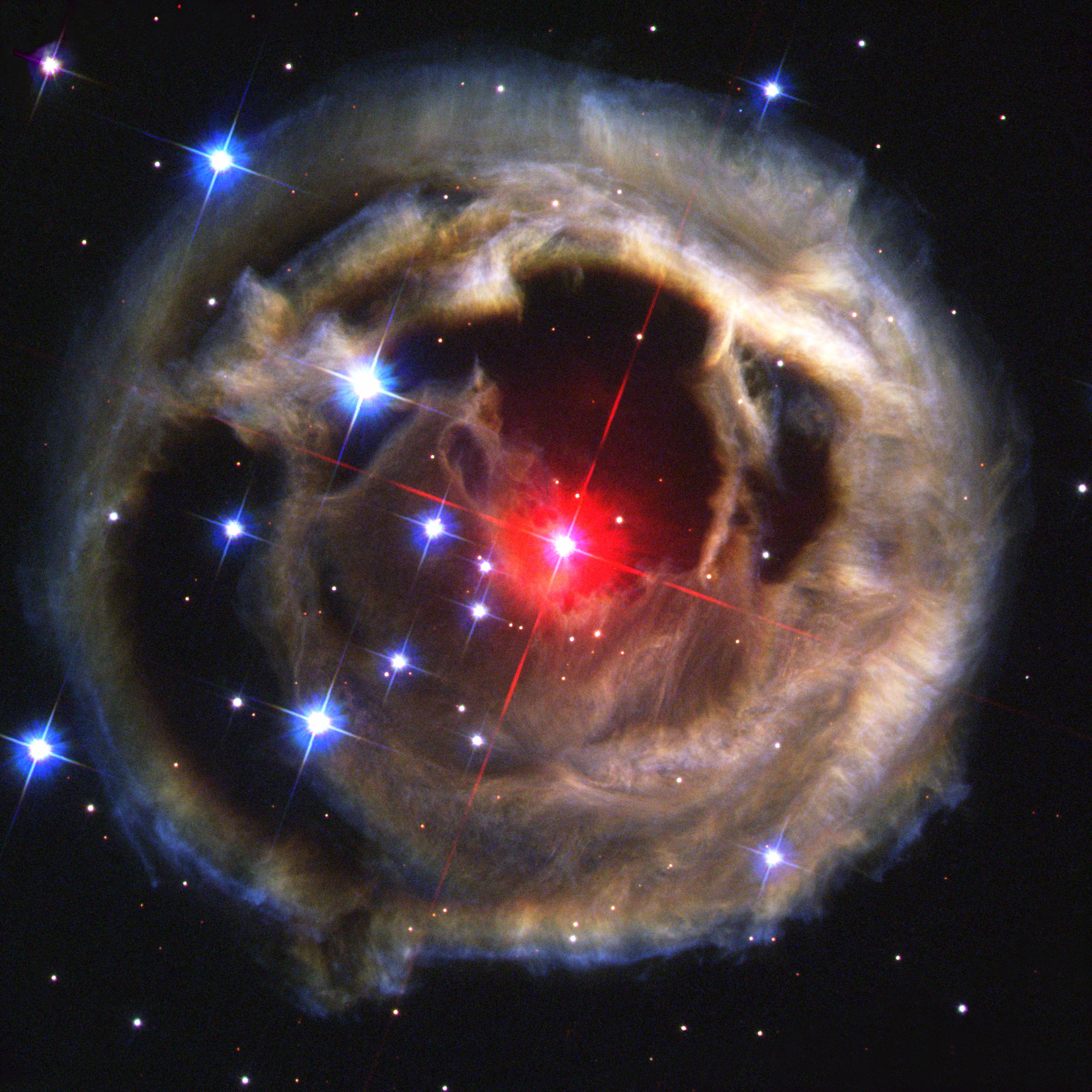
79. Echo from mysterious erupting star (Dec. 2002 image)
This is the first in a sequence of four pictures from the NASA/ESA Hubble Space Telescope’s Advanced Camera for Surveys that dramatically demonstrates the echoing of light through space caused by an unusual stellar outburst in January 2002.
The image was taken 17 December 2002. The image is combined from exposures taken through blue (B), green (V), and infrared (I) filters.
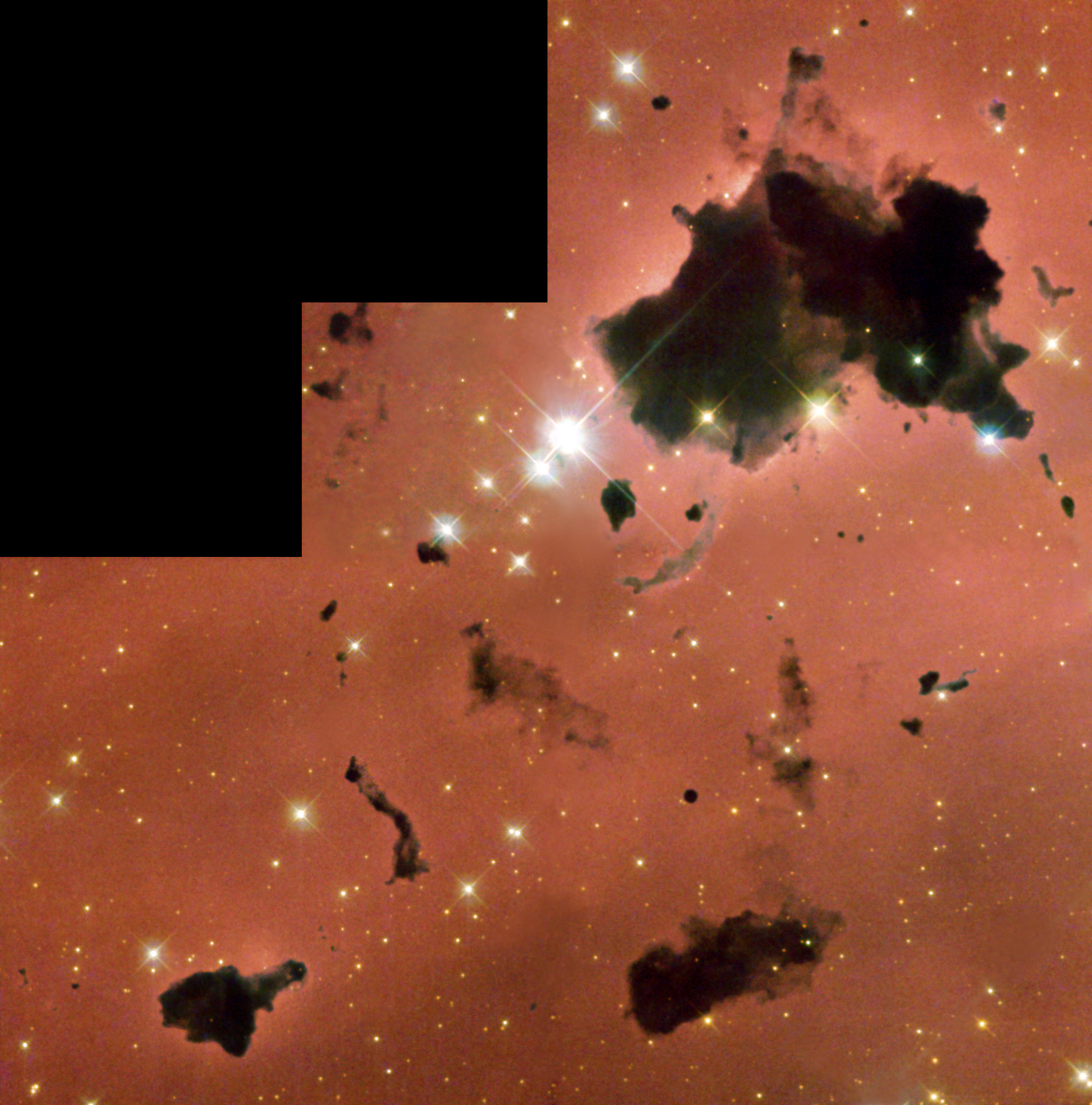
80. Thackeray’s Globules
Strangely glowing dark clouds float serenely in this remarkable and beautiful image. These dense, opaque dust clouds – known as ‘globules’ – are silhouetted against nearby bright stars in the busy star-forming region, IC 2944.
Astronomer A.D. Thackeray first spied the globules in IC 2944 in 1950. Globules like these have been known since Dutch-American astronomer Bart Bok first drew attention to such objects in 1947.
But astronomers still know very little about their origin and nature, except that they are generally associated with areas of star formation, called ‘HII regions’ due to the presence of hydrogen gas. IC 2944 is filled with gas and dust that is illuminated and heated by a loose cluster of massive stars much hotter and more massive than our Sun.

